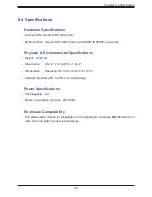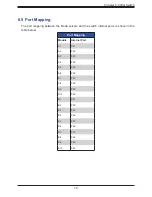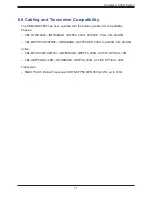
58
Chapter 5: Chassis Management Module
LED Status Indicators
LED
Color, Status
Description
Power
Green
Power on
Fault
Red
Fatal error, including power supply or thermal
Information
Blue, solid
UID activated
Blue, blinking faster than 1Hz
Firmware updating
Blue, blinking 1Hz
Indicator for active Master CMM
Capabilities
The CMM provides a dedicated, local and remote KVM (keyboard/video/mouse) connection
over an out of band TCP/IP Ethernet network during any server state (functioning, blue-screen,
powered down, BIOS and so on). It also supports Virtual Media (VM) redirection for CD, floppy
and USB mass storage devices and configures such information as the switch IP addresses.
Module Redundancy
A blade system must have one CMM and may have two for redundancy is offered only on
a specific enclosure model, which has the hardware capability to incorporate two CMM's on
one backplane. Since the CMM uses its own processor, all monitoring and control functions
are carried out regardless of the operation or power status of the blade units. CMM modules
can only be installed in the upper and/or lower right module bays.
Determining Master/Slave Modules Status
When a blade system has two CMM modules, they are assigned a master/slave status. This
is done automatically with the default primary CMM specified for per each enclosure, while
there will be no redundant in certain enclosures.
If the master CMM is powered down or removed (or is being reset by its user), the second
(slave) CMM module will then immediately be assigned as the master. The redundant CMM
mode is only offered on specific chassis models. The slave uses the previous master IP
config in case of failover.
Note
: The Slave CMM keeps the same log/status as the Master CMM and uses the previous
master IP config.
















































